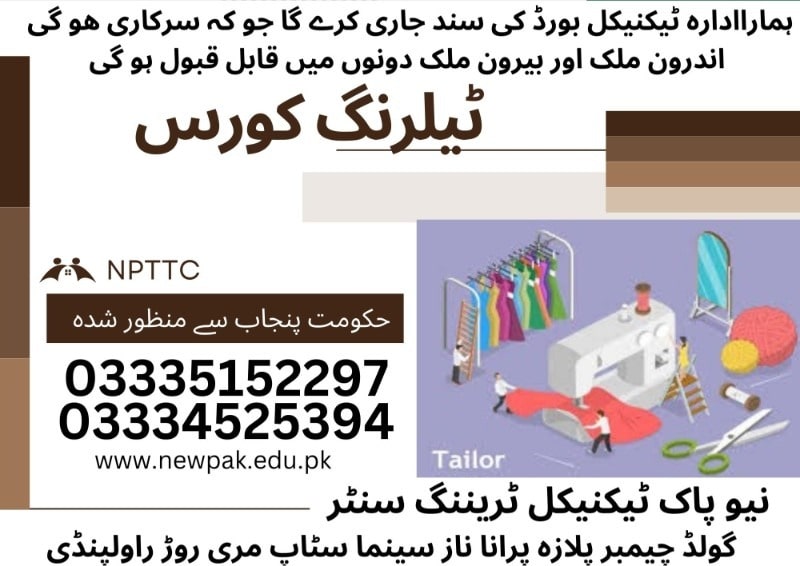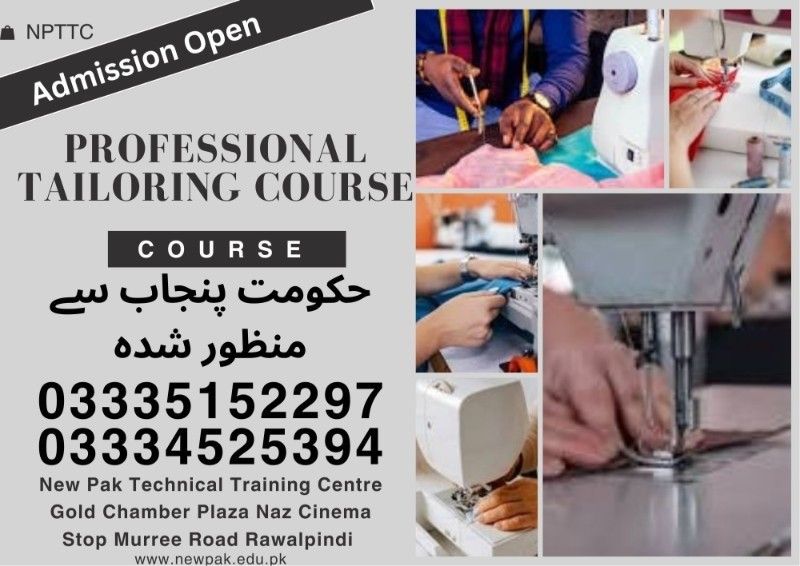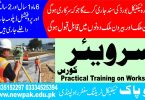
Tailoring Course in Rawalpindi Islamabad
Tailoring is a course that teaches students the techniques and skills required to design and create custom-fitted clothing. The stitching course covers a range of topics, including fabric selection, pattern making, sewing techniques, and fitting. Students will learn how to create garments that are stylish, comfortable, and fit perfectly. The course is designed for individuals who are passionate about fashion and want to pursue a career in the tailoring industry.
Course Overview
The Professional Tailoring course offers a deep dive into the art of tailoring, combining theory with practical skills to equip students with the necessary tools to design, construct, and fit garments with precision. Ideal for anyone passionate about fashion and tailoring, the stitching course provides in-depth knowledge in pattern making, sewing techniques, and the business of tailoring. Whether you’re looking to create custom garments or follow a career in fashion design or retail, this course offers the perfect foundation.

Course Duration
06 | Months
-
Basic stitching and machine operation
-
Cutting and stitching Shalwar Kameez
-
Baby frocks and shirts
Buttonholes, hooks, and zips
-
Garment finishing and corrections
Design variations (frocks, plazo, sleeves) -
Neckline designs and trouser stitching
Stitching complete dresses -
Final project, test, and certification
01 | Year
-
Basic stitching and machine operation
-
Cutting and stitching Shalwar Kameez
-
Baby frocks and shirts
Buttonholes, hooks, and zips
-
Garment finishing and corrections
Design variations (frocks, plazo, sleeves) -
Neckline designs and trouser stitching
Stitching complete dresses -
Maxi & designer frocks
-
Bridal and boutique-style garments
-
Decorative cuts, frills, and layering
-
Tailoring for children (seasonal, soft fabric)
-
Boutique business setup and client handling
Portfolio development -
Final project, test, and certification
Course Outline (6 Months)
Introduction of cutting & Stitching
Month 1
- Introduction to tailoring and its scope
- Identification and usage of tailoring tools
- Understanding types of fabrics
- Operating sewing machines (threading, bobbin setting, etc.)
- Practice with basic stitches (straight, backstitch, hemming)
- Cutting and stitching plain Shalwar
Basic Garment Construction
Month 2
- Body measurement techniques
- Drafting and cutting Kameez
- Stitching plain Kameez with side slits
- Practice with Simple Frocks and Baby Frocks
- Piping and hemming basics
Professional Finishing & Practice
Month 3
- Cutting and stitching Open Shirts, Simple Shirts, and Baby Shirts
- Buttonholes, hooks, and zips
- Final practice of stitched items (Shalwar, Kameez, Frock, Shirt)
- Project submission: 2 stitched outfits
- Practical test and feedback
Fashion Design Variations
Month 4
- Cutting and stitching of:
- Umbrella Frock
- Panel Frock
- Plazo Pants
- Designing and shaping Puffed and Umbrella Sleeves
Neckline Designs & Trousers
Month 5
- Stitching:
- Simple Neck
- V-Neck
- Round Neck
- Collars
- Cutting and stitching Trousers
- Baby-size stitching and variations
Performance Review Evaluation
Month 6
- Corrections, finishing, and lining practice
- Practice of complete dresses
- Stitching 3 complete garments for the final project
- Final test + viva + certificate distribution
Course Outline (1-Year)
Months 1–6: Essentials of Tailoring Course in Rawalpindi Islamabad
(Same course content as the 6-month program but with more detail, role-plays, and practices.)
Advanced Garments
Month 7
- Cutting and stitching Maxi-style and Designer Frocks
- Decorative cuts, frills, and fabric layering techniques
Bridal & Boutique
Month 8
- Cutting and stitching for:
- Fancy Party Dresses
- Cultural Designs
- Bridal Style garments
- Advanced use of lace, beads, and piping
Tailoring for Children
Month 9
- Stitching complete baby suits
- Seasonal baby clothing designs
- Handling soft and stretchable fabrics
Business Tailoring
Month 10
- Boutique setup guidance
- How to manage tailoring orders
- Dealing with customers and measurements professionally
- Pricing and time estimation techniques
Portfolio Development
Month 11
- Completion of 4–5 stitched garments as final samples
- Preparing a personal tailoring portfolio
- Fitting, quality check, and corrections
Final Project
Month 12
- Viva + test of all modules covered
- Display and review of portfolio work
- Certificate awarding ceremony
- Career counseling and next-step planning
Benefits of 1-Year Course
- Gain practical skills in sewing, pattern making, and garment construction.
- Learn to create basic garments like shirts, pants, and skirts.
- Develop an understanding of fabric types and their uses.
- Build confidence in using sewing machines an
Specialization Options
- Bridal and Formal Wear: These courses delve into intricate techniques for crafting wedding gowns, suits, and formal attire.
- Menswear Tailoring: Learn how to tailor garments specifically for the male body, focusing on different fabrics and styles.
- Embroidery and Embellishment: Explore hand and machine embroidery techniques to add decorative touches to garments.
- Leatherwork: Master the skills of working with leather for creating bags, jackets, and other accessories.

Career Opportunities
- Custom Tailor
- Alteration Specialist
- Fashion Designer
- Costume Designer
- Fashion Consultant
- Fashion Retail Professional
Conclusion
The tailoring course in Rawalpindi Islamabad is an excellent opportunity for individuals interested in the tailoring industry. The dress designing course provides a comprehensive understanding of the techniques and skills required to design and create custom-fitted clothing. Graduates can pursue a variety of career opportunities in the tailoring industry, including Custom Tailor, Alteration Specialist, Fashion Designer, Costume Designer, Fashion Consultant, and Fashion Retail. Overall, this course equips graduates with the necessary skills and knowledge to succeed in the tailoring industry and pursue their passion for fashion through professional tailoring classes.






